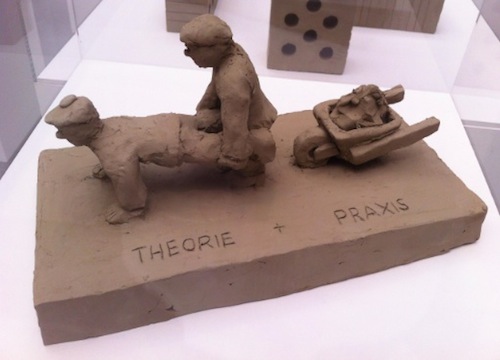
Ragnar Kjartansson’s S.S. Hangover, a repurposed Icelandic fishing boat, in which a crew of tuxedo-clad musicians played a composition for brass instruments while ferrying the boat from one dock to the next in a procession that recalls the sixteenth century Venetian tradition of floating Theaters of the World. Photo: Natalie Musteata.
A city from a bygone era, Venice is de facto made contemporary every two years by the presence of the biennale. But between Massimiliano Gioni’s rather historical, “research-driven” Fifty-Fifth International Art Exhibition, Il Palazzo Enciclopedico (The Encyclopedic Palace), and the reconstruction of Harald Szeemann’s 1969 landmark survey of conceptual art, When Attitudes Become Form, this floating city is drifting towards the past rather than future.
The year 1895, when the Lumière brothers’ invented cinema and German physicist Wilhelm Röntgen’s discovered x-rays, was also the year of the first Venice Biennale. Modeled on the world fair, this biennale was for more than half a century (until the establishment of the São Paulo Biennial in 1951) the only international show of its kind devoted to contemporary art. In the 1990s, however, when the number of biennials skyrocketed, growing from approximately twenty in the mid-1980s to over sixty in the mid-1990s, one could hardly anymore contend that there was a scarcity of exhibitions focused on recent art practices around the globe.
Today there are roughly 110 international biennials. A consequence of this biennialization, which itself is the result of the collapse of the Soviet Union and simultaneous onset of globalization, is the worldwide homogenization of art production and distribution. Despite the gross proliferation of contemporary art biennials, the past few iterations of the Venice Biennale have continued to serve as launching pads for the careers of emerging artists, or as previews for the works on sale weeks later at Art Basel. That is, until now.
Gioni’s The Encyclopedic Palace takes its title from Italian-American folk artist Marino Auriti, who in 1955 got a U.S. patent for his Palazzo Enciclopedico, a 136-story museum intended to house all human knowledge. In the Arsenale, the exhibition opens with Auriti’s unrealized architectural model surrounded by a sequence of black and white photographs of Nigerian hairstyles—an ethnographic catalogue begun by self-taught artist J. D. ‘Okhai Ojeikere in the 1960s. Such dialogues between artists of vastly different backgrounds and interests abound in the exhibition. Oftentimes, the overarching link between artists grouped together is a proclivity towards compiling, systematizing, and organizing typologies of varied sorts. One of the most arresting visual comparisons has American cartoonist R. Crumb’s graphic novel of all fifty chapters of The Book of Genesis (2009) wrapped around a circular room containing a quasi-anthropological display of terracotta dragons, demons, and totemic figures by Shinichi Sawada, a self-taught Japanese sculptor, who suffers from severe autism.
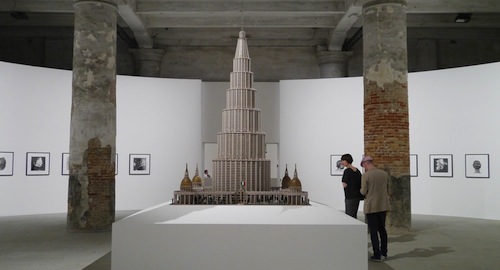
Center: Marino Auriti. “The Encyclopedic Palace of the World,” ca. 1950s; background: J. D. ‘Okhai Ojeikere’s photographs of Nigerian hairstyles, c. 1960s & 1970s.
Although an extensive amount of videos and films—including a large-scale installation by Stan VanDerBeek, Movie Mural (1968), and a newly commissioned “sculptural theater” by Ryan Trecartin—are featured in the Arsenale, in the Giardini the installation consists predominantly of paintings and sculptures. Highlights include Austrian artist Maria Lassnig’s “body-awareness paintings,” Swiss psychotherapist Carl Gustav Jung’s elaborate illuminated manuscript, Romanian artist Andra Ursuta’s miniature models of her childhood home, and Fischli and Weiss’s whimsical collection of over 200 unfired clay sculptures. In one of the smaller rooms in the central pavilion, Gioni has orchestrated a visually striking tête-à-tête between the machine-embroidered textile collages of the recently rediscovered Romanian neo-avant-garde artist Geta Brătescu and a group of anonymously produced tantric paintings.
Blurring the lines between insider and outsider, professional and autodidact, past and present, the biennale itself verges at times on the “archive fever” trend of the last decade. In several ways, the exhibition is utterly contemporary: not only does it address our Internet-driven age (Wikipedia is, after all, the twenty-first century version of Auriti’s utopian construct), but it also reflects a timely interest in idiosyncratic “collections.” Currently on view in England are several shows featuring wunderkammer displays of objects and artworks from disparate times and places that provide insight into “the world we live in”: Brian Dillon’s Curiosity: Art and the Pleasures of Knowing at Turner Contemporary; Ralph Rugoff’s Alternative Guide to the Universe at the Hayward Gallery; and Mark Leckey’s The Universal Addressability of Dumb Things at Nottingham Contemporary (see my first travelogue entry). And yet, the biennale’s effect is one of anachronism. Out of the 155 artists in the show 37 are dead male artists (a figure that rivals the amount of living women artists included). Even though the biennale does, in fact, feature a majority of artists born after 1975, many of their works, it seems, were chosen for their visual congruity with their more historical counterparts.
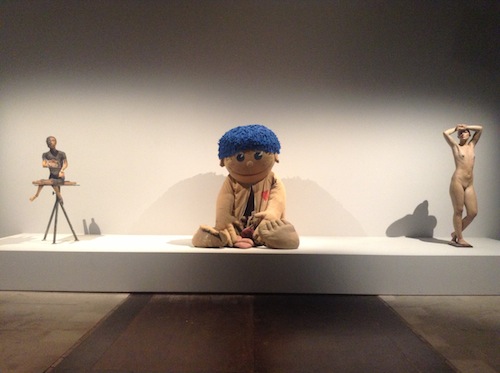
The introduction to Cindy Sherman’s artist-curated section of the Venice Biennale, 2013. Photo: Natalie Musteata.
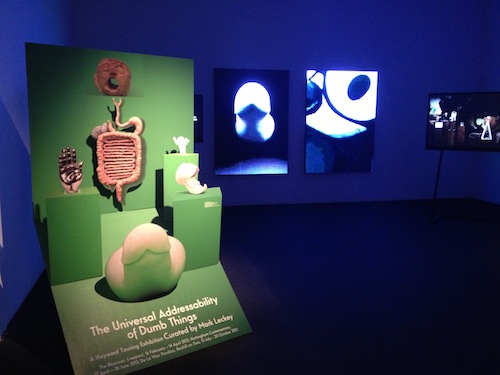
Mark Leckey’s computer-generated simulation of his exhibition “The Universal Addressability of Dumb Things,” on view at Nottingham Contemporary through June 30, 2013. Photo: Natalie Musteata.
Curator of the Eighth Gwangju Biennale (2010), the Fourth Berlin Biennial (2006), and Manifesta 5 (2004), and now Associate Director of the New Museum in New York, Gioni is no stranger to curating large-scale exhibitions. For the Venice Biennale, however, he says he attempted to change the rules by mining new strategies and display formats, and by learning directly from artists. Little surprise, then, that Gioni invited Mark Leckey to exhibit a virtual rendition of the aforementioned techno-atavistic show the artist recently organized, as well as Cindy Sherman to curate a subsection of the biennale. Sherman’s “exhibition within an exhibition” is a survey of works of the human body: Charles Ray’s disturbingly oversized mannequin of a business woman, Duane Hanson’s unnervingly lifelike polyvinyl sculpture of one of his neighbors, and John DeAndrea’s oil-painted bronze cast of a classical female nude are but a few examples. Her presentation is disconcertingly similar to Mike Kelley’s curatorial venture of 1993, The Uncanny (see my second travelogue entry), which not only included some of the same artists and pieces—for instance, Paul McCarthy’s Children’s Anatomical Educational Figure (1990), a giant ragdoll whose internal organs spill out of its stomach—but also featured a photographic series of mannequins and prosthetics by Sherman herself.
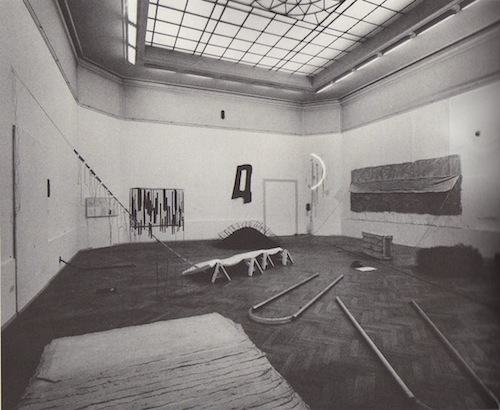
Harald Szeemann. “Live in Your Head: When Attitudes Become Form. Works – Concepts – Processes – Situations – Information” at Kunsthalle Bern, 1969.
Several Venetian canals away, another historic exhibition has also been uncannily revived this summer. At Fondazione Prada’s Ca’ Corner della Regina, curator Germano Celant, artist Thomas Demand, and architect Rem Koolhaas have recreated Szeemann’s historic show When Attitudes Become Form—an undertaking that reinforces the current retro-craze of the art world. If the critical prefix of the 1980s and ‘90s was “de” or “dis,” as in deconstruct, dismantle, and discontinue, that of the 2000s has unquestionably been “re,” as in restage, reinvent, and reevaluate. In the last decade, artists, curators, and scholars have explored the idea of historical reconstitution. While some artists have adopted the rhetoric of reportage, carefully recomposing events of the past as a means of questioning the visual and mnemonic representation of history (think of Jeremy Deller’s The Battle of Orgreave, 2001), others have engaged in acts of reenacting pioneering actions from the late 1960s and ‘70s (think of Marina Abramovic’s Seven Easy Pieces, 2005). Curators, on the other hand, have turned their attention to what Terry Smith calls “recurating,” a tendency focused on recovering exhibition histories (think of Kari Conte and Florence Ostende’s Retracing Exhibition, 2009, in which they reconstructed sections of the Independent Group’s 1953 exhibition Parallel of Life and Art). Unquestionably, the contemporary remake of Szeemann’s show belongs to the latter group.
First presented in 1969 at the Kunsthalle Bern in Switzerland, When Attitudes Become Form was originally met with derision and received exceedingly negative reviews. “When Platitudes Become Form,” “Sabotage in the Art Temple,” and “Is Art Finally Dead?” are the headlines it received from critics at the time. Szeemann’s authorial concept and his idiosyncratic, crowded display, however, quickly gained the show a cult-like status. In the last decade it has been the subject of, or inspiration for, several exhibitions: How Latitudes Become Forms (Walker Art Center, 2004); When Lives Become Form (Museum of Contemporary Art Tokyo, 2008); and When Attitudes Became Form Become Attitudes (CCA Wattis Institute for Contemporary Arts, 2012).
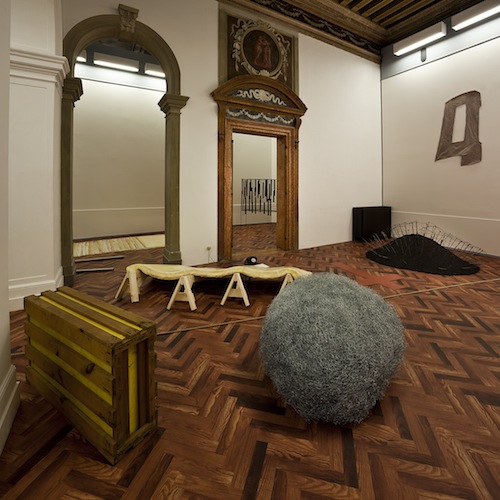
Germano Celant, Thomas Demand, and Rem Koolhaas. “When Attitudes Become Form: Bern 1969/Venice 2013” at Fondazione Prada’s Ca’ Corner della Regina, 2013.
The most recent homage to it, When Attitudes Become Form: Bern 1969/Venice 2013, features an almost 1:1 reconstruction of the show’s original floor plan in an eighteenth century Venetian palazzo. Those works that could be located have been reassembled and placed in their initial positions. Where pieces are missing, the curators have affixed a documentary photograph of the original work and delimited, with dashing grey lines, the space it occupied (like the chalk outlines drawn by policemen in the aftermath of a crime scene). I imagine the desire to recreate the exhibition was to visualize an often-written about, but relatively unseen exhibition. As a scholar of exhibition history, the experience was invaluable; but, with architectural partitions where there should have been none, documentary photographs where there should have been works, and baroque frescoes where there should have been unadorned walls, the exhibition was far from an exact replica. It was, instead, intriguing and novel.
Natalie Musteata is Blogger-in-Residence through June 28, 2013.

